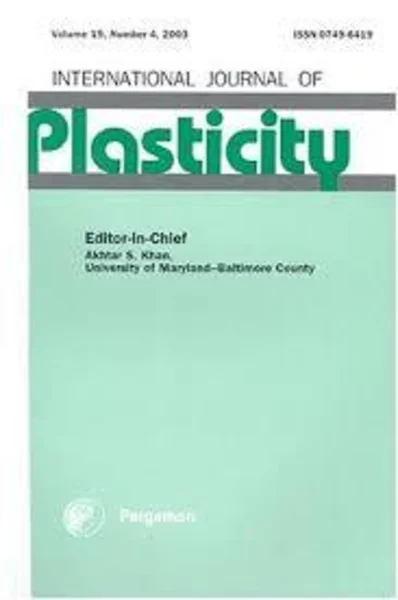-
a physically-based constitutive model for anisotropic damage in rubber-toughened glassy polymers during finite deformation
جزئیات بیشتر مقاله- تاریخ ارائه: 1390/01/01
- تاریخ انتشار در تی پی بین: 1390/01/01
- تعداد بازدید: 767
- تعداد پرسش و پاسخ ها: 0
- شماره تماس دبیرخانه رویداد: -
the present work focuses on the development of a physically-based model for large deformation stress–strain response and anisotropic damage in rubber-toughened glassy polymers. the main features leading to a microstructural evolution (regarding cavitation, void aspect ratio, matrix plastic anisotropy and rubbery phase deformation) in rubber-toughened glassy polymers are introduced in the proposed constitutive model. the constitutive response of the glassy polymer matrix is modelled using the hyperelastic–viscoplastic model of 12 and 14. the deformation mechanisms of the matrix material are accounted for by two resistances: an elastic–viscoplastic isotropic intermolecular resistance acting in parallel with a visco-hyperelastic anisotropic network resistance, each resistance being modified to account for damage effects by void growth with a variation of the void aspect ratio. the effective contribution of the hyperelastic particles to the overall composite behaviour is taken into account by treating the overall system in a composite scheme framework. the capabilities of the proposed constitutive model are checked by comparing experimental data with numerical simulations. the deformation behaviour of rubber-toughened poly(methyl methacrylate) was investigated experimentally in tension at a temperature of 80 °c and for different constant true strain rates monitored by a video-controlled technique. the reinforcing phase is of the soft core–hard shell type and its diameter is of the order of one hundred nanometers. the particle volume fraction was adjusted from 15% to 45% by increments of 5%. the stress–strain response and the inelastic volumetric strain are found to depend markedly on particle volume fraction. for a wide range of rubber volume fractions, the model simulations are in good agreement with the experimental results. finally, a parametric analysis demonstrates the importance of accounting for void shape, matrix plastic anisotropy and rubber content.
مقالات جدیدترین رویدادها
-
استفاده از تحلیل اهمیت-عملکرد در ارائه الگوی مدیریت خلاقیت سازمانی و ارائه راهکار جهت بهبود
-
بررسی تاثیر ارزش وجوه نقد مازاد بر ساختار سرمایه شرکت های پذیرفته شده در بورس اوراق بهادار تهران
-
بررسی تأثیر سطح افشای ریسک بر قرارداد بدهی شرکت های پذیرفته شده در بورس اوراق بهادار تهران
-
بررسی تأثیر رتبه بندی اعتباری مبتنی بر مدل امتیاز بازار نوظهور بر نقد شوندگی سهام با تأکید بر خصوصی سازی شرکت ها
-
تأثیر آمیخته بازاریابی پوشاک ایرانی بر تصویر ذهنی مشتری پوشاک ایرانی (هاکوپیان)
-
مروری بر آزمایش های مربوط به ستون های لوله فولادی بیضوی پر شده با بتن خود متراکم
-
روش های کاهش واریانس در روش مونت کارلو
-
ارزیابی مشخصات ژئوتکنیکی مخلوط های ماسه و پودر تایر با استفاده از ماسه بندر امیر آباد
-
effect of ethylenediaminetetraacetic acid (di sodium salt) and aquasoft 330 on crystal growth and morphology of calcium oxalate
-
wetting considerations in capillary rise and imbibition in closed square tubes and open rectangular cross-section channels
مقالات جدیدترین ژورنال ها
-
مدیریت و بررسی افسردگی دانش آموزان دختر مقطع متوسطه دوم در دروان کرونا در شهرستان دزفول
-
مدیریت و بررسی خرد سیاسی در اندیشه ی فردوسی در ادب ایران
-
واکاوی و مدیریت توصیفی قلمدان(جاکلیدی)ضریح در موزه آستان قدس رضوی
-
بررسی تاثیر خلاقیت، دانش و انگیزه کارکنان بر پیشنهادات نوآورانه کارکنان ( مورد مطالعه: هتل های 3 و 4 ستاره استان کرمان)
-
بررسی تاثیر کیفیت سیستم های اطلاعاتی بر تصمیم گیری موفق در شرکتهای تولیدی استان اصفهان (مورد مطالعه: مدیران شرکتهای تولیدی استان اصفهان)
-
تحلیل رشد کتابخوانی و اثرات آن بر جامعه انسانی در اندیشه مقام معظم رهبری
-
نقش اخلاق حرفه ای اسلامی در موفقیت سازمان های پروژه محور ایران
-
بررسی تأثیر رضایت مندی و اعتماد مشتریان از گارانتی بدنه سایپا در نمایندگی 2110 گروه خودروسازی سایپا استان اردبیل
-
بررسی تاثیر ارزهای دیجیتال بر صادرات غیر نفتی: شواهدی از صنایع دستی کشور ایران
-
بررسی اصول و قواعد حاکم بر قرارهای تأمین در پرتو آیین دادرسی کیفری مصوب سال 1392




سوال خود را در مورد این مقاله مطرح نمایید :